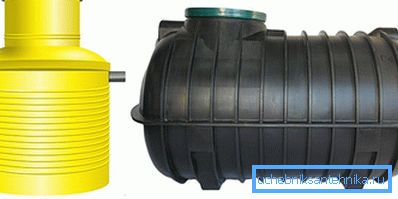How to choose a septic tank to give
Cottage - a great place for all kinds of recreation: as a family, and in a large noisy company. But do not forget that in the country there are not many benefits of civilization, so the water supply and sewage system must be built independently. In most cases, homeowners dig a special hole, which, as it is filled with drains, is pumped out with the help of cesspool equipment. But there is another way - it is a septic tank, a full-fledged autonomous treatment plant. A large range of sizes and modifications complicate the selection process. How to choose a septic tank to give, how it works and what the main types of septic tanks are, we will discuss in this article.
Types of septic tanks

Having studied the entire classification and features of each type of sewage treatment plant, it is possible to simplify the problem with the choice. Today, manufacturers offer users three basic types of septic tanks:
- Drives. Serve as a standard sump. Its walls are lined with bricks, reinforced concrete rings are installed, or automobile tires are laid. It needs to be pumped out.
- Anaerobic. All wastewater that enters the system is recycled and treated with special anaerobic bacteria.
- Aerobic. Modern types of tanks that are equipped with compressors and aerators. To work they must be connected to the power supply. Waste water is purified by 98%, therefore, mining can be discharged into the ground.
In addition, they can be installed in two positions:
- vertical installations look like ordinary barrels, but they take up little space;
- the horizontal ones are presented in the form of a tank that is buried in the ground, therefore it is necessary to select a separate section for them.

In addition, the containers vary in material production:
- brick;
- metal;
- concrete;
- plastic.
The internal design of a simpler septic tank is presented in the form of three sections, each of which performs its functions:
- The first section is the collection of garbage, wastewater and food waste.
- The second section is the decomposition of inorganic and organic substances.
- The third section is a settling tank.
To carry out a complete treatment of wastewater, they must pass through a layer of soil. To do this, dig a trench or a special filter well.
The principle of operation of the septic tank

It is important to properly study the whole principle of operation of septic tanks, which will allow you to make the right choice. So, as already mentioned, in the first compartment accumulate all the drains, where sedimentation takes place. In addition, at this stage there is an accumulation of surface-active substances, fats and solid large particles. They all settle at the bottom, where they are processed by microorganisms to the state of sludge.
The separated water enters the second section, where as a result of various anaerobic processes, all organic compounds will precipitate. All clarified liquid passes to the next tank. Here is the soil filtration, that is, biological treatment. A special compressor, if necessary, supplies air to the septic tank so that the disintegration process is accelerated.
Some manufacturers will improve the system of operation of septic tanks, so the principle of operation of some models may differ.
Criteria for choosing a septic tank
Having studied the designs and all models of purification systems, you can proceed directly to the selection. To determine which is better septic, it is necessary to examine the main factors:
- The size of the structure should be calculated based on the number of people who live in the country. It is also necessary to take into account the number of sanitary appliances.
- The type of soil and the condition of groundwater at the site where the entire filter system will be located is also taken into account. The ideal location for a septic tank is not a hill, but a nisin, since drains will flow here without any difficulty.
- Frequency of use of a septic tank:
- permanent;
- in certain seasons (for example, in summer).
- Price. Not only the type of construction, but also the volume will depend on the prices.
- Popularity of a design: there is a special rating in which all models are exposed depending on popularity. It is based on user opinions.
- Electricity consumption. Many models, despite the popularity, use a sufficiently large amount of electricity.
For a large family, a large, volatile reservoir with several chambers is best, and for a couple of people, a non-volatile mini-septic tank with a small reservoir will suffice.
As you can see, a large number of criteria and factors affect the choice of a septic tank. All of them must be considered in order to choose a model that can cope with the tasks set by the user. Do not worry about unpleasant odors, as modern drugs are designed to eliminate them.
Video
This video describes the features of the choice of a septic tank to give: